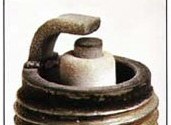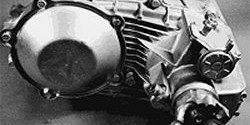|
Regular tune-ups are an important part of your ATV or truck’s maintenance. A tune-up keeps your rig riding in an optimal state and allows your motor to give you the most power and the greatest efficiency possible. In a car, there are predetermined times when tune-ups and maintenance should be performed. Your off-road rig however, doesn’t fall into the manufacturer’s convenient categories because of the abuse, extreme situations, and unusual environments we subject them to.
What brand of spark plug do you use?
Aside from poor performance, a great way to read the health of your engine is by examining the spark plugs, and you don’t have to wait months to do this. Checking one or all of your spark plugs will give you a quick read of your engine’s health with little effort.
By examining the spark plug’s insulator color, even a less-than-mechanically-inclined person can determine valuable information about the engine’s overall operating condition.
|
Normal: Grey to Light Golden-Brown Color
- This condition is ideal, the spark plug and engine air/fuel mixture are operating properly.
|
 |
|
Dry Fouling: Black Soot Buildup
- Air/fuel mixture is too rich, the carburetor settings are incorrect, or the flame arrestor is dirty or has mounting problems.
- Spark plug heat range is too cold for the operating conditions.
- Ignition system problems causing a weak or intermittent spark.
|
 |
|
Wet Fouling: Shiny, Wet, Black Appearance
- Excessive use of the choke (gas fouled)
- Prolonged low rpm operation (gas or oil fouled)
- Fuel to oil ratio is too rich (oil fouled)
|
 |
|
Excess Deposits: Bumpy, Chalky Buildup
- Poor fuel quality
- Oil leakage into combustion chamber
- Improper oil used for premix/injected
|
 |
|
Overheated: White, Blistered, Melted Electrode
- Lean air/fuel mixture
- Spark plug heat range is too hot for operating condition of the engine
- Plug is not properly gapped and/or torqued onto head
- Overly advanced timing
|
 |
|
Breakage: Sooty appearance, missing or damage components of the spark plug
- Caused by thermal expansion/contraction of the insulator – Typically due to thermal shock (the sudden increase or decrease in temperature)
- Sudden decreases in temperature can most commonly be coincided with entering a large pool of water while the engine is hot, or a broken water jacket for liquid-cooled engines.
|
 |
|
Detonation: silver or black specs, melting or breakage at the firing tip
- Caused by improper timing
- Lean air/fuel mixture can aggravate this condition
|
 |
In addition to the signs above, if you find that a condition has occurred suddenly, particularly fouling or excessive heat, these conditions should be traced as quickly as possible to prevent possible engine damage.
|
 4x4Review Off Road Magazine
4x4Review Off Road Magazine








